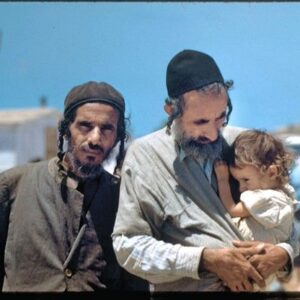For over two centuries, Americans have been participating in an ongoing survey asking us to declare the color of our skin. While it may seem like the U.S. Census is nothing more than a nuisance that shows up once every ten years – since 1790, it has been a tremendous logistical and financial undertaking, costing taxpayers 6.3 billion dollars in 2020 alone.[i] However, the true cost of the U.S. Census isn’t simply financial. It plays a key role in determining the “ethno-racial order” of our country,[ii] contributing to the current social hierarchies and political systems that we have today. From a social standpoint, the Census influences both how we identify ourselves, as well as how we identify and are identified by others. However, this time around, one group in particular underwent a strange and involuntary “racial makeover.” According to the 2020 United States Census, People of North African and Middle Eastern descent are now officially considered “White.” [iii]
That’s right – the census has taken a group of people that White America has unjustly declared war on for over two decades – both abroad as well as in our own country – and apparently decided to call them White. Consequently, some people of North African and Middle Eastern descent now sarcastically refer to themselves as “White [only] on paper.” Not only do they miss out on the unmerited benefits and privileges of being considered White, but also all too often, they face blatant discrimination and violent hatred from many White Americans. Even within the most liberal and progressive communities, one would be hard pressed to find a single White person that would identify a friend from Saudi Arabia, Iran, Egypt, or Yemen as being White. Since when has America been a Muslim friendly country? Oh, that’s right – never…
White people still undoubtedly (and unfortunately) remain at the top of the social order – nothing has changed in that regard. However, up until the year 2020, never in U.S. history has a group of non-European descent been allowed into the most discriminatory “top-tier.” And despite People of North African and Middle Eastern descent now “belonging” to the category of people by which they have felt most vehemently oppressed, the decision to include an entirely new group into the realm of Whiteness potentially represents an unprecedented shift in the racial hierarchy of our country.
So how on Earth did this anomaly occur? Why call them White in the first place? Well as it turns out – the answer lies in unrestrained racism. Strange as it may seem, this “newly” defined parameter of Whiteness isn’t actually new at all. Designating specific people of Middle Eastern ancestry as White is actually in alignment with a term that goes back almost three centuries – “Caucasian.” Both the term itself, and more importantly, the concept of Caucasian is attributed to the founder of modern Anthropology, Johan Friedrich Blumenbach – a devoted White supremacist.
During the 1700’s, Blumenbach devised the term “Caucasian” for those who lived west of the Caucasus mountain range spanning the border of Europe and Asia. [iv] Fast forward to 2020 – millions of people of Middle Eastern descent are suddenly re-categorized as White (i.e. Caucasian) who “just so happen” to fit precisely within the designated geographical range devised by Blumenbach. Far from a coincidence, a modern political map of the Middle East can confirm this “inadvertent” connection. Case in point, while American immigrants from Iran and Afghanistan can now technically call themselves White, Pakistani immigrants are still expected to designate themselves as “other Asian.” Unlike its next-door neighbors, Pakistan doesn’t quite fall within the specified geographical range – whereas the other two countries are safely nestled within the “Caucasus zone.”
As a firm supporter of racial superiority, Blumenbach devised that in addition to one’s place of origin, skull shape (i.e. forehead, nose structure, cheek bones, jawline, etc.) and physical beauty (as defined by him) were also instrumental in determining whether someone was considered Caucasian.[v] He also believed that the Caucasian race represented God’s intended version of human physical appearance – and that others fell short of the mark.[vi] In other words – Blumenbach’s entire premise for the creation of this particular racial category was to elevate what he believed was the most superior form of the human race. Blumenbach genuinely thought that God Himself intended for people to look like him – and he created an entire science to back it up.
So what? Just because the term “Caucasian” is rooted in racist ideology doesn’t mean that us modern folks actually believe any of this, right? Well considering the Johan Blumenbach was the person responsible for not only the creation of an entire category of race, but also an entire category of science – we can’t simply detach the term (nor the science) from its original intent. White supremacy was baked into the foundation of anthropology itself – it was exclusively intended for “us” to study “them” – not the other way around. The term and category of Caucasian set us apart as the ones who were superior and had been divinely crafted – giving us permission to study our “inferior” counter parts.
While the term “Caucasian” itself did not appear on the 2020 census, the problem with unintentionally resurrecting this specific category is that it is rooted in Blumenbach’s admittedly racially biased standard for defining White people. Consequently, the current re-categorization of specific people of Middle Eastern descent on the 2020 Census, invokes a category built entirely upon racial supremacy.
While there was likely no conscious or deliberate intent in revamping Blumenbach’s version of Whiteness – this is a powerful example of how racism can (unintentionally) span across centuries. And despite constantly fluctuating categories of racial demographics from one census to the next, the subjective results are converted into hard data that in-turn affects immeasurable parts of how our society operates each decade – from electoral districts to policy decisions including immigration, law enforcement, education, and healthcare. The 2017 Muslim ban clearly indicates that despite the fact that someone from the Middle East can now legally declare themselves White according to Blumenbach’s antiquated parameters, our current social and political structures will likely not be so accommodating.
Undeniably, the ramifications of this socially and politically charged re-classification will have a profound impact on the statistical make-up of this country in the coming decade. As the White population gets a representational boost – taking into account the desires, demands, and power of the “White population” as well as the “White vote,” it remains to be seen what the effects are of being able to bolster our numbers on paper. One thing is for sure, despite their renewed designation as White, the White folks from North Africa and the Middle East will not be given the same rights or respect of their European-descent counterparts. And almost undoubtedly, their racial status will once again be called back into question come 2030. So to my Middle Eastern and North African White kin – Welcome (back) to the club… at least for now.
[i] https://www2.census.gov/about/budget/census-fiscal-year-20-budget-infographic-2020-census.pdf
[ii] https://scholar.harvard.edu/jlhochschild/publications/racial-reorganization-and-united-states-census-1850-1930-mulattoes-half-br
[iii] https://www.census.gov/mso/www/training/pdf/race-ethnicity-onepager.pdf
[iv] Scene on Radio – (Made in America – Seeing White, Part 8) NPR
[v] Scene on Radio – (Made in America – Seeing White, Part 8) NPR
[vi] Brace CL. “Race” is a four-letter word: the genesis of the concept. New York: Oxford University Press; 2005.
david
Related Posts
- 4 weeks ago
- 4 weeks ago
- 6 months ago
- 7 months ago
One thought on “White on Paper”
Leave a Reply Cancel reply
You must be logged in to post a comment.





You are an insane sexist racist. Seek therapy